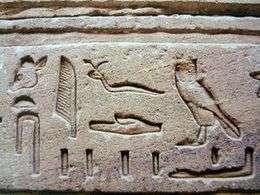hieroglyph
English

Egyptian hieroglyphs typical of the Graeco-Roman period.
Etymology
First attested around 1598, a back-formation from hieroglyphic (1580s), from Middle French hiéroglyphique, from Late Latin hieroglyphicus, from Ancient Greek ἱερογλυφικός (hierogluphikós) (Plutarch τά ἱερογλυφικά [γράμματα] "hieroglyphic [writing]), ἱερόγλυφος (hierógluphos, “carver of hieroglyphs”) (Ptolemy), a compound of ἱερός (hierós, “sacred, holy”) and γλυφή (gluphḗ, “carved work”), a calque of Egyptian mdw nṯr (“the god’s word”),
.[1]
Pronunciation
- IPA(key): /ˈhaɪɹəˌɡlɪf/
Noun
hieroglyph (plural hieroglyphs)
- An element of an ideographic (hieroglyphic) writing system.
- (informal) Any obscure or baffling symbol.
Derived terms
Translations
element of ideographic writing system
|
|
Verb
hieroglyph (third-person singular simple present hieroglyphs, present participle hieroglyphing, simple past and past participle hieroglyphed)
- To represent by hieroglyphs.
References
- James P[eter] Allen (2010) Middle Egyptian: An Introduction to the Language and Culture of Hieroglyphs, 2nd edition, Cambridge: Cambridge University Press, →ISBN, pages 2, 177.
This article is issued from
Wiktionary.
The text is licensed under Creative
Commons - Attribution - Sharealike.
Additional terms may apply for the media files.